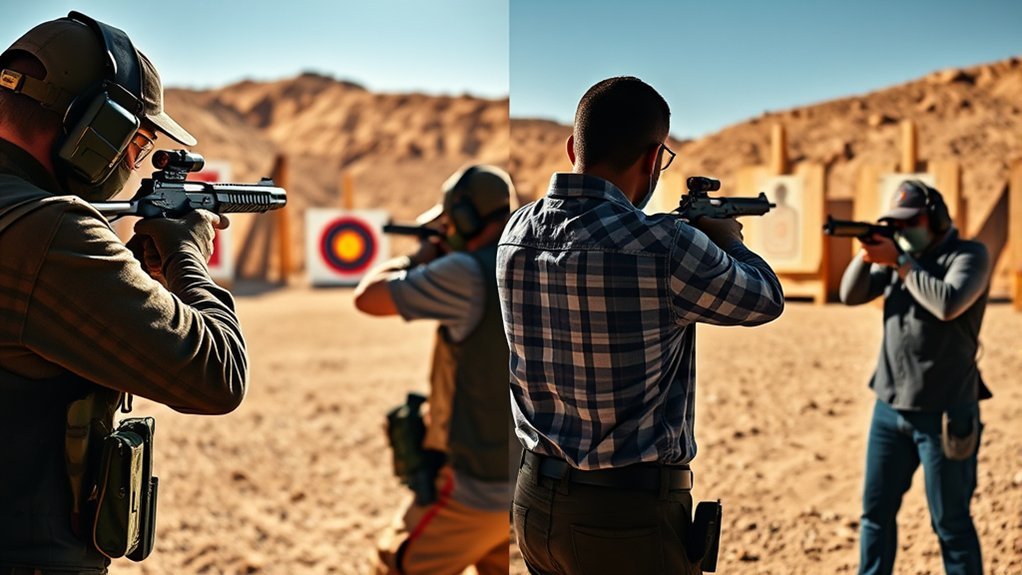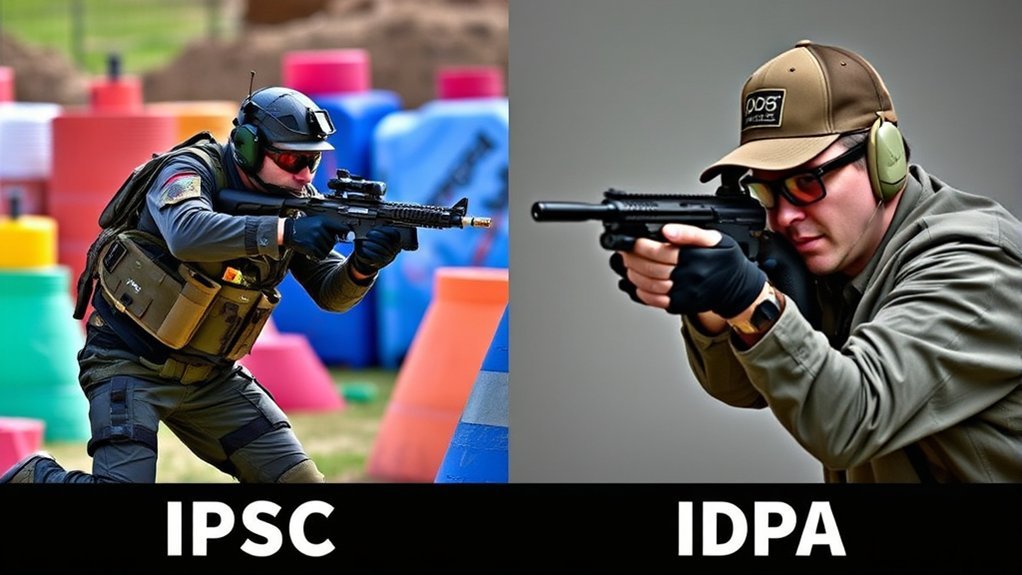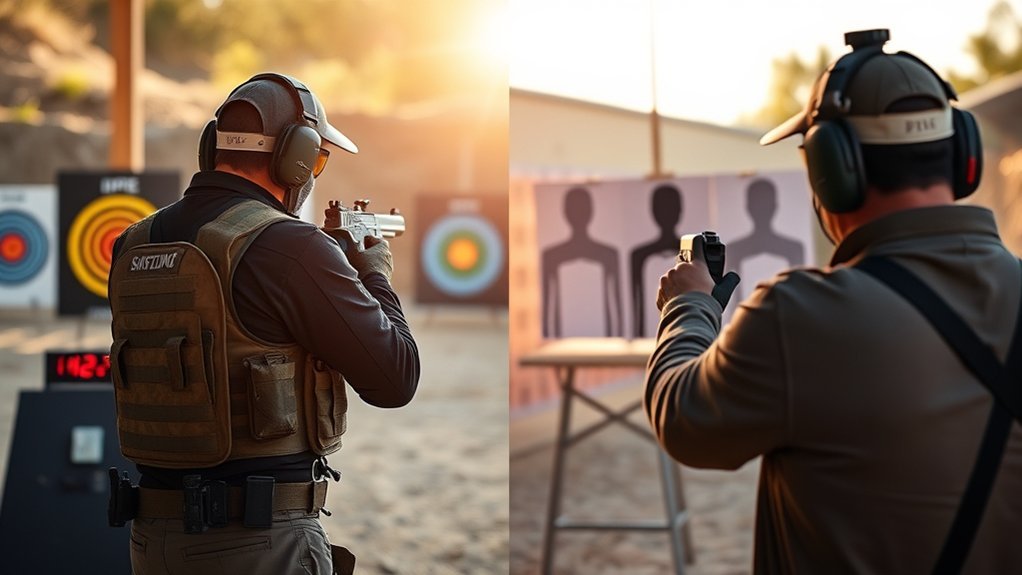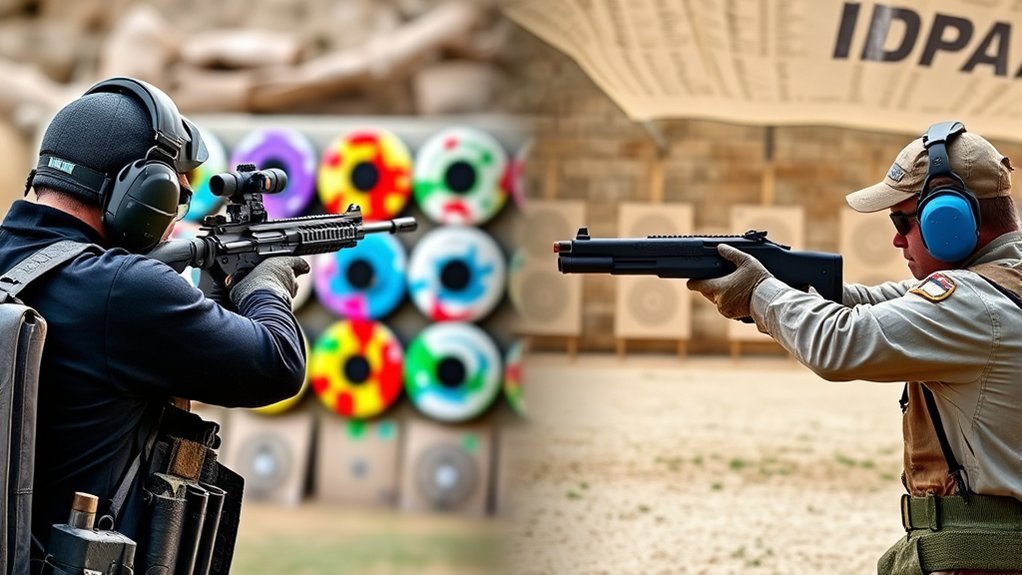In the world of competitive shooting, the choice between IPSC and IDPA can feel like choosing between a finely tuned sports car and a rugged off-roader. Each sport presents its own set of rules and challenges, tailored to different styles and philosophies of shooting. As you explore their unique frameworks, you’ll discover how their scoring systems, equipment requirements, and competition formats shape the experience for participants. What nuances might surprise you as you compare them?
Overview of IPSC Rules and Regulations

When you plunge into the world of IPSC (International Practical Shooting Confederation) shooting, you’ll quickly notice that its rules and regulations are designed to guarantee safety, fairness, and competition integrity. Central to these rules is the emphasis on safe firearm handling. Every competitor must adhere strictly to safety protocols, ensuring that the sport remains enjoyable for all participants. Additionally, stages are designed to test various shooting skills under time constraints, promoting strategic thinking. Scoring is based not only on accuracy but also on speed, encouraging a balanced approach. Furthermore, competitors are classified into divisions based on equipment and shooting style, fostering a competitive yet equitable environment. Understanding these rules is essential for any aspiring IPSC shooter.
Overview of IDPA Rules and Regulations

While exploring the domain of IDPA (International Defensive Pistol Association) shooting, you’ll find that its rules and regulations prioritize practicality and real-world scenarios. IDPA emphasizes using your everyday carry firearm and gear, ensuring competitors face challenges similar to those in self-defense situations. Scenarios often involve moving between cover, engaging targets from different positions, and utilizing tactical decision-making. Safety is paramount, with strict guidelines on muzzle discipline and handling firearms. You’ll also notice a focus on time efficiency, as stages are designed to test your speed while maintaining accuracy. Participants must adhere to specific divisions based on their equipment, fostering a level playing field. This structure encourages shooters to hone their defensive skills in a competitive yet realistic environment.
Scoring Systems in IPSC and IDPA

Although both IPSC (International Practical Shooting Confederation) and IDPA utilize scoring systems designed to evaluate performance, they do so with different emphases that reflect their distinct philosophies. In IPSC, your score is mainly based on time, with penalties for misses and no-shoots affecting your final result. It encourages speed and accuracy, rewarding those who can shoot quickly while maintaining precision. In contrast, IDPA focuses on scenario-based shooting, where scoring accounts for both time and accuracy, but emphasizes real-world self-defense situations. Here, you’ll face penalties for procedural errors, promoting tactical decision-making. Understanding these differences can help you adapt your strategy and improve your performance in each discipline, aligning your skills with the scoring priorities of either organization.
Equipment and Gear Requirements
Understanding the scoring systems in IPSC and IDPA sets the stage for the importance of equipment and gear requirements in each discipline. Both organizations have specific rules that guarantee safety and fairness, but they differ in certain aspects.
| Equipment Type | IPSC Requirements |
|---|---|
| Holster | Must be strong-side or race holster |
| Magazines | Must be loaded to division limit |
| Clothing | No restrictions on color or style |
In IDPA, you’ll find a focus on concealment, while IPSC emphasizes speed and accuracy. Knowing these requirements helps you prepare effectively for each competition, guaranteeing you meet the standards while maximizing your performance potential.
Competition Formats and Stages
As you immerse yourself in the competition formats and stages of IPSC and IDPA, you’ll quickly notice that each organization employs distinct approaches to challenge shooters. IPSC focuses on speed and accuracy, featuring dynamic stages that incorporate movement and multiple shooting positions. You’ll face diverse scenarios, often with a mix of targets and obstacles, pushing your skills to the limit.
In contrast, IDPA emphasizes real-world self-defense scenarios. Stages are designed to replicate everyday situations, requiring you to engage targets while adhering to cover and concealment principles. You’ll find yourself assessed not just on speed but also on tactical decision-making. Both formats require different strategies, and understanding these nuances can greatly enhance your performance in each discipline.
Conclusion
In summary, whether you prefer the fast-paced action of IPSC or the practical scenarios of IDPA, each sport offers unique challenges that cater to different shooting enthusiasts. Some may argue that IPSC is too focused on speed, but the emphasis on accuracy guarantees that every shot counts. Ultimately, both disciplines enhance your shooting skills and promote safe handling, making them worth exploring. So, why not immerse yourself in both and discover which one fits your style best?

